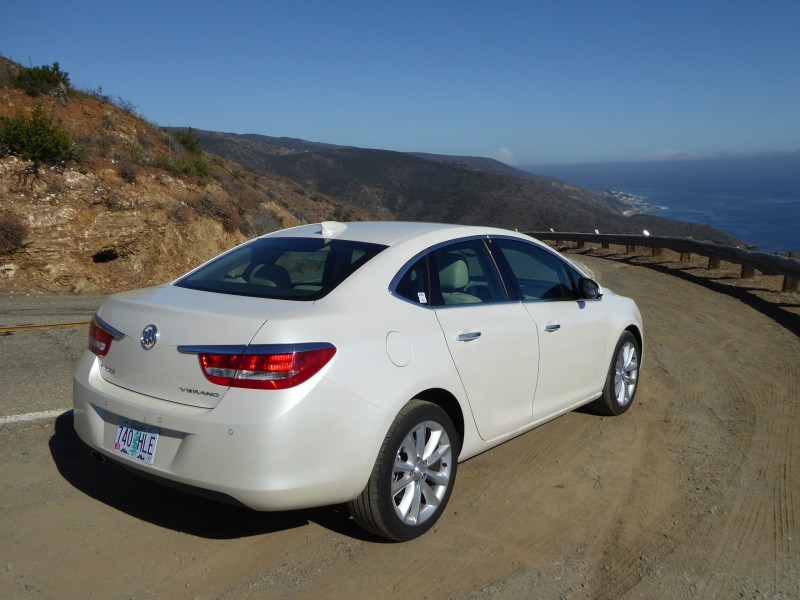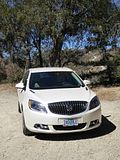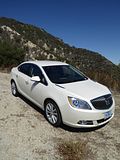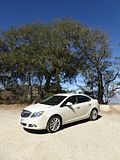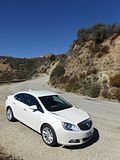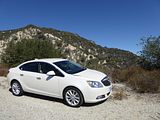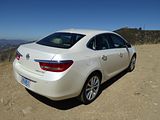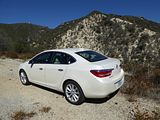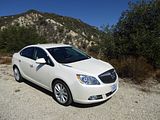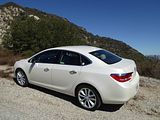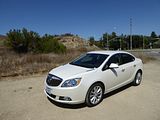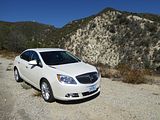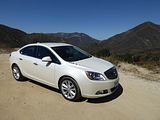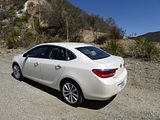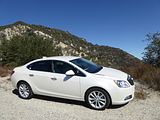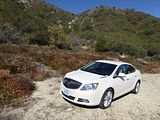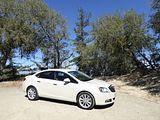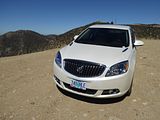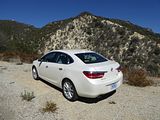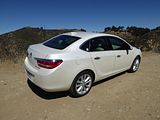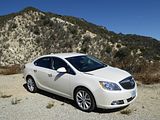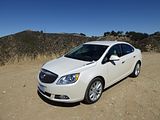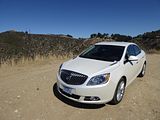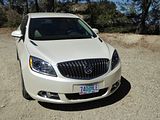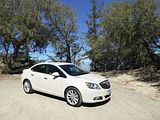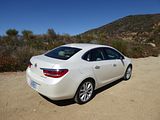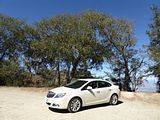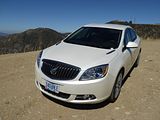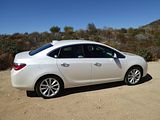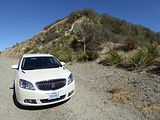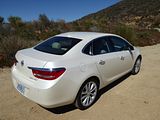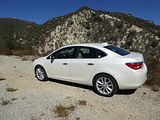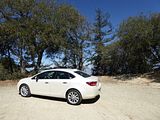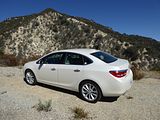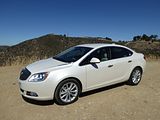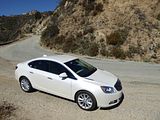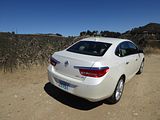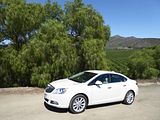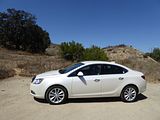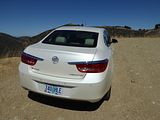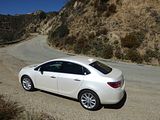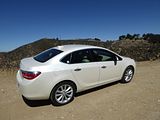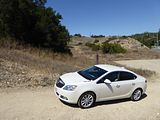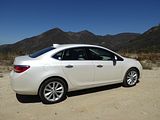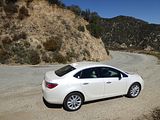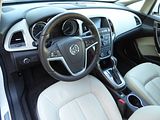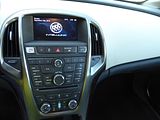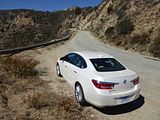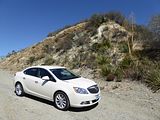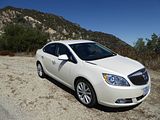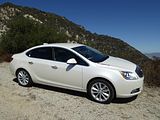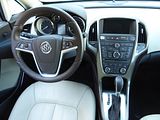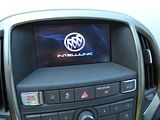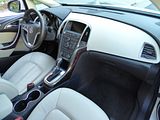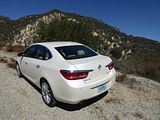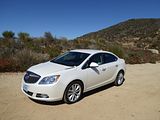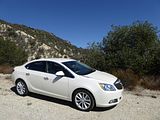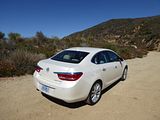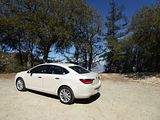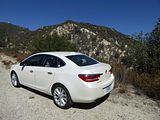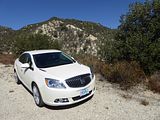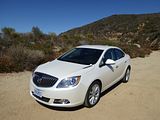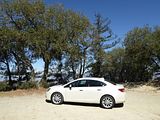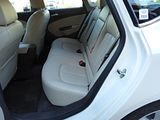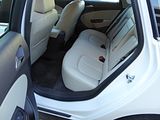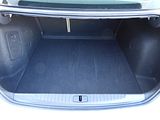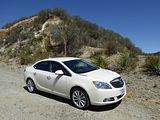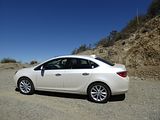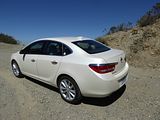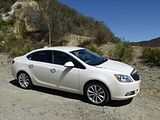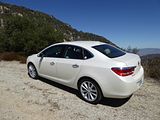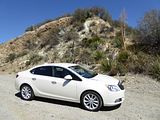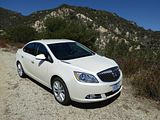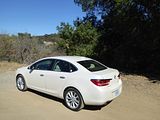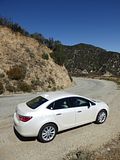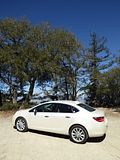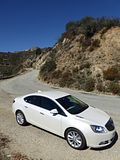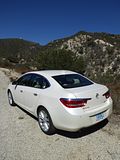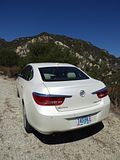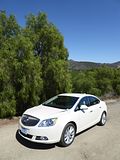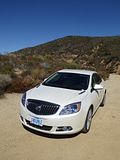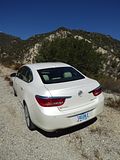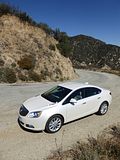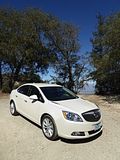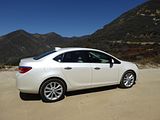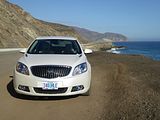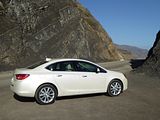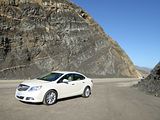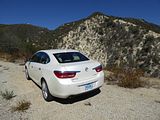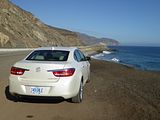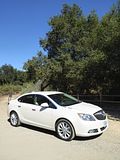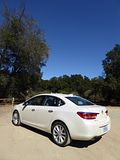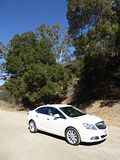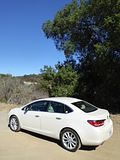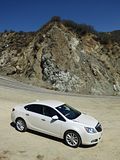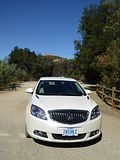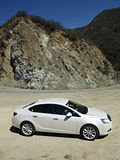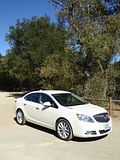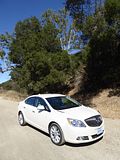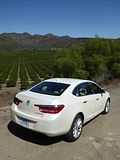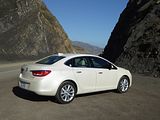
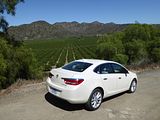
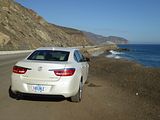
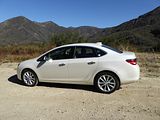
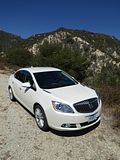

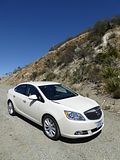
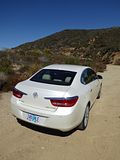
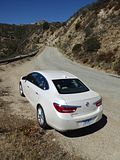
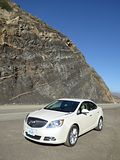
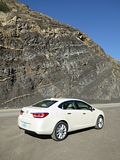
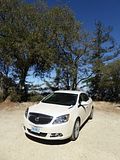
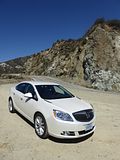
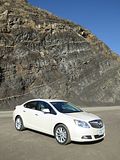
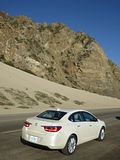
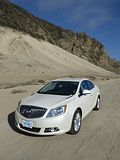


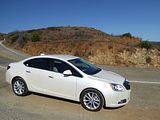
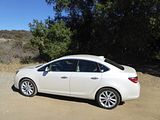
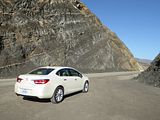
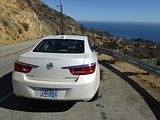
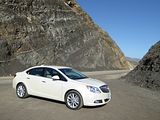
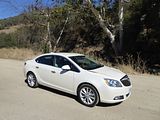
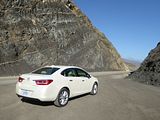
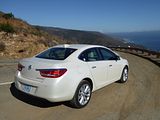
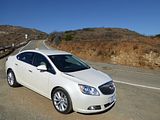


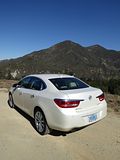
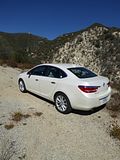
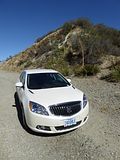
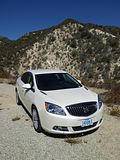
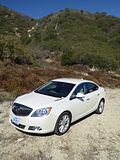
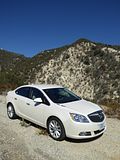

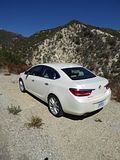

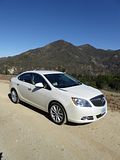
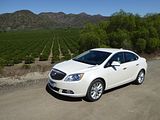
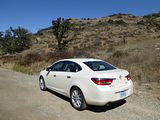
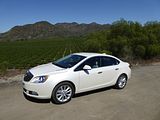
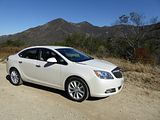

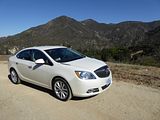

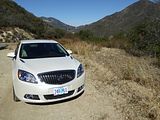
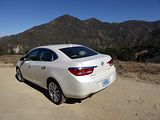
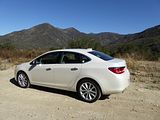
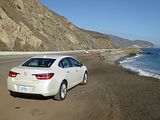
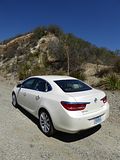
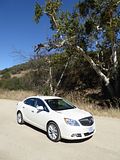

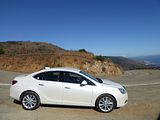
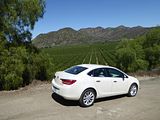



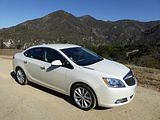
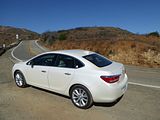
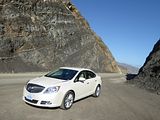
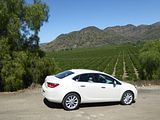
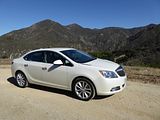
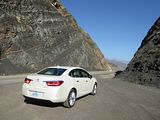
Verano had a style all of its own, unlike the Regal, which really does look like an Insignia with a Buick grille on it. But appearances can be deceptive, as under the skin, this car shares a lot with the J generation of the Vauxhall/Opel Astra and the Chevrolet Cruze. The smallest Buick for a generation, the new car was based off the Delta II platform that also underpins the Chevrolet Cruze, with dimensions that make it almost uncomfortably close to those of the larger, Epsilon II-based Regal. At 181″ long, it is just 9″ shorter than its big brother, and only 2″ narrower and less than half an inch lower. It was clear that this was a Buick, though, with not just the traditional grille on it, but the inclusion of six venti-ports on the bonnet. Whilst these may suggest a six cylinder engine, the Verano was initially launched with just the familiar 4 cylinder 2.4 litre Ecotec unit under the bonnet, and the promise of a 2 litre turbo engine to be added a few months later. The interior was far plusher than had been seen on previous Delta-II cars, with extensive use of leather and richer materials, and the standard equipment levels even on entry spec cars was going to be high, in accordance with its premium pricing. Some months after its US debut, a saloon version of the Astra was shown, for sale in those European markets that still prefer this body style to the hatchback, but although conceptually the car is the same, the styling is different, meaning that the Verano remains a US-built car for the US markets. The Verano does not neatly fit into rental car classifications, so it’s not been a model that you see in quantity at the likes of Hertz, but they have had them on fleet since 2012 and I have been trying to source one ever since then, to see what the car is like. Finally, I found the one lone example at the end of a long line of cars in the far recesses of the LAX facility, in a photography friendly colour which Buick called White Diamond Metallic, but which has a slight hint of almond to its pearlescent finish. Despite being on Oregon plates, I was able to secure it for a day to see what I thought.
Like the Regal, the Verano is only available with front-wheel drive. And also like the Regal, in all bar the top spec model, the familiar 2.4 litre four cylinder Ecotec engine with direct injection lurks under the bonnet, producing 177 bhp and 170 lb/ft, unlike the Cruze, which uses different engines altogether – either a normally aspirated 1.8 or a 1.4 litre turbocharged four cylinder, both putting out 138 bhp. Although the Verano is heavier than the Chevrolet, the extra horses ought to be enough to make the Buick decently rapid. That does not really prove to be the case. It is not a slow car, either, and is well able to keep up with the flow of traffic, but when I took the Verano up on the route 23, south from Westlake over the Malibu Hills and down to the coast, the engine had to be worked really quite hard to maintain momentum on what are some of the steeper roads I know of in the Los Angeles area. There is a standard 6 speed automatic gearbox, with two modes, the sportier of which allows you to change gears yourself, and perhaps I would have been better off using this, as leaving the transmission to its own devices, it would try to hang onto a high gear as long as possible, meaning that you had to be quite brutal with the throttle to get it to change down, on those inclines. In more normal driving, the gearbox proved very smooth, making almost imperceptible changes, and the engine went from being quite noisy on the hills, to sound quite refined and quiet. Indeed, cruising on the freeway, overall noise levels are low, noticeably so compared to other similarly sized cars. Buick make the usual impressive claims for fuel economy that you get with any car these days, but the press experience seems to have been different, with many citing it to be one of the thirstiest cars in its class. the fuel gauge seemed to drop quite quickly in my test car, too, but when I filled it up with 8.94 (US) gallons having driven 218 miles, and stabbed at the calculator, the average consumption came out at 24.38 mpg US or 29.13 mpg Imperial, which is not too bad considering the hard time the car had received on the hills.
Standard fit on all Verano models is a leather steering wheel which is just the right thickness and very pleasant indeed to hold. What a shame that the steering system to which it is connected is not quite so excellent. Actually, it is not bad, suffering like so many cars in the era of electric assistance from a slightly numb feeling around straight ahead, but this sensation largely disappears the more you turn the wheel, so once you get to the twistier routes, the Buick is actually quite a good car to punt along. Not quite at Ford levels of precision, but not far off. There is ample grip, and despite the relatively soft suspension, the Buick handles quite tidily, though there is plenty of understeer once you tackle tighter bends with gusto. How many customers will do that is a moot point. They are more likely to be interested in the ride quality, I suspect and in this regard, the Verano scores particularly well, smoothing out most of the worst of the rough and variable surfaces that you encounter on roads around Los Angeles. There were no issues with the brakes, which proved well up to the task of stopping the car in the required manner with a nice progressive feel to the pedal. There is an electronic handbrake fitted, with a small lever behind the gearlever used to set and release it, as you find on higher specification Astra models these days. As the Verano is an automatic, it is not an issue as I did not find the need to use it apart from an added precaution when parking on a particularly steep slope. The view out of the Verano is generally good, with a decent field of view from the door mirrors, but, like many cars these days with a steeply sloped front screens, the A pillars are at quite an angle. Indeed, so much so that there is a small front quarterlight in front of the doors. Looking across the car, this certainly helps with extra visibility to the side, but on the driver’s side, the pillar proved seriously obstructive, getting in the way on many a corner on a twisty road and at intersections. I would rate it as one of the most extreme cases from this styling trait I have come across in a long time, and it did prove quite irksome during my test. There are plenty of other visibility aids to help, with a warning light in the door mirrors to show that a vehicle is alongside and potentially in your blind spot. There is a standard rear-view camera which projects onto the audio display screen and there are parking sensors. There also a “vehicle ahead” warning, symbolised by a green picture of a car in the instrument display. I had to consult the manual to find out what this particular warning meant, as I could work out from when it was illuminated what it might be. In ordinary motoring, it is of questionable value, as it is almost permanently illuminated, but there could be times when it is useful.
The Verano may well have its own unique interior style and trim, but you don’t need any form of logo or badge inside it to know that this is a GM car. Biggest clue is the layout of the centre of the dash, with its large number of buttons for the Infotainment and Climate Control system, which looks just like you would find in many a more costly Vauxhall, or Chevrolet or indeed another Buick. However, what you will probably first notice is the mixture of colours and textures, certainly on the test car which had a combination of dark and very light brown for the dashboard and door casings, and some very pale tan, almost off-white leather seats. There are inlays of plastic wood, too, around the edge of the centre console and on the door armrests. Many US commentators have praised the result, citing a rich ambience. I don’t think that’s how I viewed it. The plastic wood is both nasty and unnecessary and whilst the quality of the rest of the materials is decent enough, this is way short of the ambience that you would get in an Audi, or a Volvo.
It does feel substantial, though, and everything fits together nicely, which is not something that I have said about all US market GM cars even quite recently. The dash has a single cowl covering the instruments. There are two large units, for rev counter and speedometer, with far smaller water temperature and fuel level sitting between the larger pair in the upper part of the binnacle. Although the large dials are large, they are not easy to read. The markings are quite small and the speedo is only calibrated in even multiples of 20 mph, with a lot of lines between, making it hard to tell your precise speed. Luckily, if you cycle through the information display options for the area in the middle of the instrument cluster, which you do in typical GM fashion by pressing the “Menu” button in the left hand column stalk and then twisting the collar on the end of the stalk, you will find a setting for a digital speedo, as well as trip mileometers, and indications of tyre pressure and remaining oil live. That left hand stalk is also used for the indicators. Wipers are operated by the matching right hand one, and lights from a rotary dial on the dash to the left of the wheel. The centre of the dash is at a slight angle, with the top nearer to the front of the car than the bottom. Uppermost is a colour display screen for the IntelliLink unit, which provides a mixture of audio unit functions, as well as vehicle information, and, satellite navigation if fitted, which was not the case with the test car. Below are a panopoly of buttons, with the top row used for the keyless engine start and a remote boot release. They are all quite logical, but there are an awful lot of them, to operate it. Beneath these are the rotary dials and yet more buttons for the dual zone climate control. There are some repeater functions presented on the spokes of the steering wheel.
The Cruze, on which the Verano is based, is one of the doyens of what the rental car companies call a “mid-size”, so you might assume that they would class the Verano the same. Not the case, at least at Hertz, where it is in the same group as the full-sized models, such as the Toyota Camry, Ford Fusion and Chevrolet’s own Malibu. The reason given is that the quality of the interior more than makes up for the slight disparity in size. Be warned, because despite Buick’s official material telling us that the cabin is only a couple of cubic feet smaller than that of the Regal, if you have lots of people and luggage, you may find that accommodation in the Buick is just too tight. With the front seats set well forward, there is ample leg room, but set them for the longer legged occupant, and those in the bag are going to struggle for space, with not much clearance between the back of the front seats and the rear seat cushion. There is just about enough width for three, though I think you need to think more of this as being a four seater car. Headroom is not an issue. There is a drop down central armrest which has twin cupholders in its uppermost surface. The driver has electric adjustment to the seat’s fore/aft and height elements, but an awkward to each lever on the side of the seat to adjust the backrest rake in a series of steps, whilst the front passenger seat is all manual in adjustment. With a steering column that goes in/out as well as up/down, getting a comfortable driving position was not hard. There is a good sized boot, which belies the looks of the rear end of the Verano. It is long from back to front, quite deep and also the full width of the car, with little intrusion from the rear wheel arches. Extra space can be created by dropping the rear seat backrests onto the seat cushions. These are asymmetrically split. There is a small amount of space under the boot floor for a few bits and pieces. Inside the cabin, there is a reasonable sized two level glovebox, bins on all four doors, a small cubby under the central front armrest and little areas both in front and behind the gearlever. There are map pockets in the back of both front seats.
There are not really different models of the Verano with trim names as you get with some cars, apart from the Premium Turbo which has the 2 litre turbo engine in it. Otherwise, there is simply the $23,380 Verano, and you can add a couple of option packs, called “with Convenience Group” and “with Leather”. Entry level models are nicely specified, with items such as 17″ alloy wheels, an alarm and vehicle anti-theft system, auxiliary power outlet, a rear view camera, cruise control, auto headlights, a leather wrapped steering wheel, GM’s IntelliLink system with a 7″ touch sensitive colour screen which includes navigation from telematics, an AM/FM radio with CD slot, MP3, XM Satellite radio, Bluetooth, a WiFi 4G LTE hotspot and GM OnStar, dual automated climate control and split folding rear seats. The “with Convenience” pack, which costs $25.020, adds a power adjustable, heated driver’s seat, heated mirrors, rear parking sensors, the lane departure warning, blind spot monitor, a universal remote garage door opener. The test car was a “with Leather”, which, listed at $27.050, as well as giving you hide trimmed seating, heated for front seat passengers, includes the keyless engine start, and a premium Bose sound system with an equalizer and 9 speakers. The top model 250 bhp Premium Turbo has the same equipment level as the “with Leather” car. Optionally, it can have a 6 speed manual gearbox. It is priced at $29,215, so a few hundred dollars less than a bare-bones Mercedes CLA250, a car which is probably one of its closer rivals.
I quite liked the Verano. It is easy to see the appeal of a premium finished small saloon like this, and the sales figures of cars such as this, and low end Audi, BMW and Mercedes models show that the market agrees. Because it is not just a hatch with a boot grafted on, as is sometimes the case with cars of this type, the Buick looks good, and there is no doubting the quality of the materials and trim, albeit in a slightly un-Audi like American way. It drives quite nicely, with impressive levels of refinement provided you do not need to push the engine really hard, with the car feeling composed and refined on the freeway. Although the interior needs a significant reduction in the number of buttons on the dashboard, I am sure that you would get used to them all, so then it comes down to the things you cannot change. Only one struck me as a serious flaw and that is the impeded front visibility from the angle of the A pillar. Whether you could ever get use to this is a moot point. You certainly need to take extra care on twisty roads and at angled intersections, and frankly, whilst care is something to be exercised at all times on our roads, something that makes the problem harder is not really acceptable any more. A new version of the Verano, based on the latest underpinnings of the Astra “K” and various Asian versions of a second generation Cruze, is said to be a matter of months away. It will be interesting to see how the model evolves. For now, then, a guarded recommendation at the rental car counter, if you have a lot of people and luggage, and be careful with that visibility.

